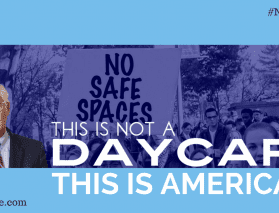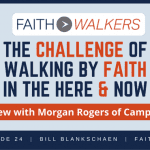I get it. Really, I do.
We’re repulsed by the utter horror of the tragedy in Newtown. Our hearts ache at the thought of such insane bloodshed. I’ve already shared my own experiences with such issues and my prayer for them as a former principal who still knows and loves so many similar teachers and kids.
And I have few little guys of my own. So I get our urge to make schools safer. I understand why we want to do all we can to make sure no one ever hurts like that again. But there is a subtle yet pernicious danger that can come from our efforts to create safer schools in Newtown and elsewhere.
If we’re not careful, we’ll create a bunker mentality that fears risk above all and defeats the very reason we have schools in the first place.
The Truth about Learning
I think we’d all agree that schools should be places where learning takes place. But learning always requires risk, because it involves moving from where we are to where we could go. And by risk, I don’t mean stupid-death-defying risk, but the risk of failure in general that must naturally occur in any thriving learning environment. It’s about ensuring kids truly live, not just survive.
The greatest risk we face these days is that of an unlived life. ~ Seth Barnes
I’m not saying we always like it, but failure, and the willingness to take risk, make mistakes, and learn from them, is the only path to success. If we’re not careful, we’ll inadvertently stifle the very culture of growth necessary to keep learning. Consequently, our “safer” schools quickly become museums where alarms sound when we touch the exhibits and the creative human spirit ages and fades before our very eyes. We end up with schools that may be physically safe but intellectually dormant.
Monotony is the awful reward of the careful. ~ A.G. Buckham
The Hazards of a Risk-Free Culture
We are rapidly becoming a nation of people averse to taking risks. When something — anything — fails, we demand an inquiry as to why. When our child fails to receive a Little League award, we insist an injustice has been done. When an accident occurs, we now assume a lawsuit will follow. When an evil, insane fellow commits heinous murders, we rush to pass more restrictive laws, ban more stuff, and tighten school security.
When we create a bunker mentality in schools through sincere efforts to make them safer, we also make them less productive places to learn. You don’t go into bunkers to move forward. Bunkers are designed for surviving, not for winning. There is a place for both, provided we’re careful.
We can think of the balance between safety and risk as a line, a continuum with total safety on one extreme and utter disregard for consequences on the other. We always find ourselves somewhere along that line in every area of life. The more we move toward safety, the more we move, by definition, away from risk. But the more we move away from risk, the less we are able to learn and grow.
That’s the paradigm in which we must function, for better or worse. That’s not to say we should rush to the end of extreme risk. We don’t need to take a field trip across a crowded highway to learn about physics. We can find a safer way. Yet the general paradigm of this universal trade-off remains. And we did not become the leaders of the free world by playing it safe. We’re the ones who stormed the beaches, put man on the moon, and insisted on ending the moral disaster of slavery no matter the cost.
“Almost every advance in art, cooking, medicine, agriculture, engineering, marketing, politics, education, and design has occurred when someone challenged the rules and tried another approach.” (Roger von Oech) In other words, they chose to take a risk instead of the safer route. I often wonder how an Einstein would function in our safe and secure learning environments, or even a Thomas Edison who famously said, “There ain’t no rules around here! We’re trying to accomplish something!”
You can’t reach for a dream and remain motionless at the same time. The two are incompatible. ~ John Maxwell
But motion means taking risks. Risk might well mean failure. Are we still OK with that?
A Symptom of a Risk-Averse Culture
In short, I fear our education system is already becoming so insulted by sincere efforts to ensure safety of all sorts that it’s a wonder any learning can take place at all. Over the last few decades, our schools have gotten safer, or at least more averse to risk in many ways (more on that later). Maybe that’s why our academic scores have remained stuck in neutral for the last three decades while other countries, more willing to take risks, pass us by.
I’ll go a step further to suggest that as a nation, we may have already passed a tipping point of sorts in this regard. We vote for the candidate who promises the most security, not the one who offers the greatest freedom to take risks and reap the rewards. When corporate and union leaders at GM make mistakes, we expect a bailout — even at a loss to those who took the most risk.
One critical role of government is to facilitate safety as we each take risks every day as individuals, families, or businesses. It plays a necessary role in ensuring minimal safety and security standards are met. But at some point, subtly passed and difficult to delineate, that safety system instead becomes the reason for our existence. At one point, it existed to keep us safe as we grew and took risks. Now we seem to exist to fund its own ever-expanding appetite for more safety regulations, bureaucratic paperwork, and blame-shifting commissions.
Meanwhile, every day, a little bit more of our cultural creative spirit fades until we forget why we existed in the first place.
I know it’s a bit of stretch, but I’ve been thinking a little beyond just the natural wish we all have that such a tragedy never happen again. I pray you won’t think me callous because of it. Just trying to think ahead. At some point, maybe a point already passed, we protect ourselves to death in a futile attempt to ensure we dispose of all hurt and failure.
But without some level of risk, we simply can’t learn. And isn’t that why we want safer schools in the first place?











